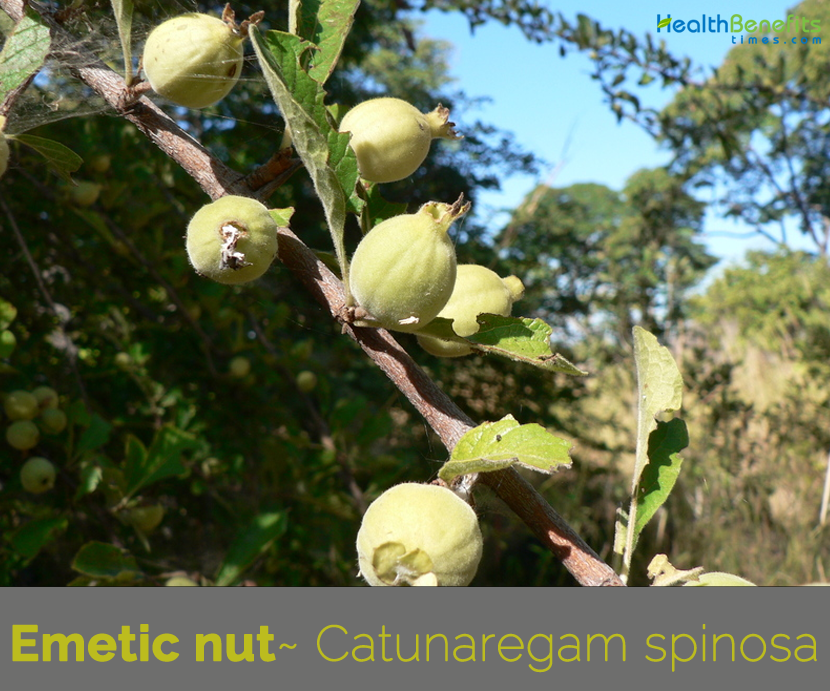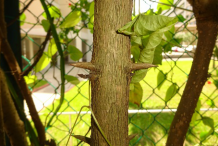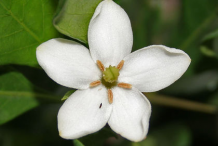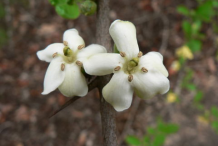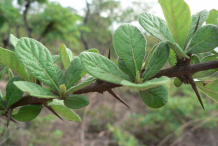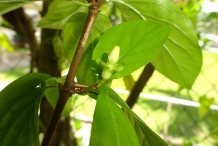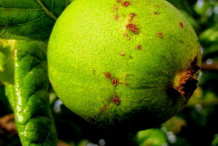Plant Description
Emetic nut is a spiny, large deciduous thorny shrub or small tree that grows about 5 m tall. The plant is found growing in the foothills, scrub jungles, dry deciduous forests, monsoon forest understory and coastal sands. Branches are horizontal, rigid, paired spines sharp and woody. Lateral branchlets are short, suppressed. Leaves are simple, ovate, wrinkled, clustered, obovate-oval to spathulate, base tapered, obtuse to pointed apex, veins reticulate and sessile. Flowers are yellowish white, 1-3 at ends of suppressed branchlets. Fruits are 1.8-4.5 cm long, globose or broadly wide, longitudinally ribbed or smooth, crowned with persistent calyx limb. They are green when young turning to yellowish brown as they mature. Fruit consists of numerous seeds 0.4-0.6 cm long, compressed, smooth, brown and very hard. Since it is a medicitree it is used to treat cough, asthma, ulcers and many other ailments.
Traditional uses and benefits of Emetic Nut
- Extracts of the barks of cassia fistula and this tree is mixed with small chilies and the juice is taken to cure vomiting and diarrhea.
- Leaves are used to prepare medicine for fever.
- Roots mixed with oil are applied for relief from body pains.
- The herb possesses anti-bacterial activity and is used against various bacterial infections.
- It is used in treatment of asthma, rhinitis, and cold.
- It is very effective to reduce the inflammation and helpful in the treatment of edema, rheumatism.
- It has pain killer action. It is used in stomach pain.
- It enhances the immunity of body and offers energy to fight against various infections.
- It is one of the powerful medicines used for emesis. It is used in emesis therapy in Ayurveda. It is used in various poisonous cases.
- It is used in treatment of skin diseases, ulcers, flatulence and coeliac disease.
- It also helps to reduce the cholesterol level.
- Pasted emetic nut is very useful in treating inflammatic disorders and abscesses.
- Emetic nut is the best herb for induce vomiting and helps to relieve kaph and pitta disorders.
- Powder of emetic nut put in warm water mix honey and sendha namak and drink empty stomach.
- Emetic nut is a cough expectorant herb and beneficial for curing respiratory troubles like cold, cough and asthma.
- Emetic nut is a blood purifier and useful in skin diseases.
- Fruit is beneficial useful in menstrual problems like amenorrhea and dysmenorrhea and others.
- The fruit is useful in cases of acute bronchitis and asthma.
- The fruit is applied externally in fever.
- Bark is used internally and externally as an anodyne in the treatment of rheumatism and to relieve the pain of bruises and bone aches during fevers.
- In Indo-China, powdered and roasted fruits (without seeds) are used externally to treat ulcers.
- Bark is used internally against diarrhea and dysentery and to regulate menses.
- Plant is used there in traditional medicine to treat bronchitis, asthma, leucoderma and diseases of the brain, and the fruit pulp for poulticing sores.
- Infusion is administered orally as an emetic and to relieve fever, nausea, general coughs, toothache, and pains during pregnancy, dizziness, menorrhagia, depressed fontanelle, snakebites and gonorrhea.
Ayurvedic Health benefits of Emetic nut
- Phlegm: Powder 2 Emetic nut. Put it in ¼ glass of water and keep it overnight. In the morning mix the mixture and take. It gives you relief through vomiting.
- Fever: Prepare a decoction of bark of Emetic nut tree. Take half glass once a day.
- Cough: Take 2 dried Emetic nut. Grind. Have it with lukewarm water once a day.
- Ulcers: Powder Emetic nut bark. Make a paste of Emetic nut bark with little water. Apply it on ulcers twice a day.
- Acne: Grind fruit of Emetic nut tree. Apply on affected parts twice a day for half an hour.
- Teething problems: If a child is suffering from teething problems, rub the fruit pulp of Emetic nut tree over the jaws and gums. It gives relief to the child.
- Flu: Prepare a decoction of bark of Emetic nut tree. Take one cup once a day.
- Head Lice: Extract the juice of Emetic nut. Apply on the scalp thrice a week for 20 minutes.
- Phlegm: Take 10 gram Liquorice, 5 gram Emetic Nut Seeds, 1 teaspoons honey and 1 teaspoons rock salt. Boil Liquorice and Emetic Nut’s seeds in one glass of water. Add Honey and Rock Salt. Mix it well. Take it thrice a day. It causes vomiting and Phlegm comes out.
- Stomach Ache: Take 2 pinches seeds of Emetic Nut Tree. Grind with Vinegar. Heat. Apply lukewarm mixture on naval.
- Asthma: Take equal amount of Emetic Nuts, Sodom Root, and Liquorice. Grind them together. Have 2 pinches once a day with water.
- Cold: Take Emetic Nuts, Liquorice, Sodom in equal quantity. Powder them together. Have one pinch once a day. It gives relief in Cold conditions.
Other Facts
- Fruit is used in calico-printing, and in dyeing as a color intensifier.
- Bark is used as a dye.
- Fruits are used by Hindus at the time of marriage ceremonies.
- In Indo-China, it is often planted in fences.
- Wood is commonly used in India as fuel wood.
References:
http://www.theplantlist.org/tpl1.1/record/kew-36206
https://en.wikipedia.org/wiki/Catunaregam_spinosa
https://uses.plantnet-project.org/en/Catunaregam_spinosa_(PROSEA)
Comments
| Emetic nut Quick Facts | |
|---|---|
| Name: | Emetic nut |
| Scientific Name: | Catunaregam spinosa |
| Origin | South Asia and other Asian countries |
| Colors | Yellowish brown |
| Shapes | 1.8-4.5 cm long, globose or broadly wide, longitudinally ribbed or smooth |
| Taste | Astringent |
| Health benefits | Beneficial for asthma, rhinitis, cold, skin diseases, ulcers, flatulence, coeliac disease,amenorrhoea and dysmenorrhoea |
| Name | Emetic nut |
|---|---|
| Scientific Name | Catunaregam spinosa |
| Native | South Asia and other Asian countries |
| Common Names | Common emetic, Emetic nut, Karegida, Mountain Pomegranate |
| Name in Other Languages | Arabic: Jauzulaki, Ji jul kai Assamese: Behmona, Gurol, Mona Bengali: Karhar, Mainphal, Mayanaphala Chinese: Cìzi (刺子), Cì liú (刺榴), Shān shíliú (山石榴), Niútóu lè (牛头簕), Lè gǔ mù (簕牯木) English: Common emetic, Emetic nut, Karegida, Mountain Pomegranate Gujarati: Mīṇḍhaḷa (મીંઢળ) Mindhal, Mindhol, Mindhar Hindi: Mainphal (मैनफल) Kashmiri: Madanfal Kannada: Kaarekaayi-gida (ಕಾರೆಕಾಯಿ ಗಿಡ), Maggaare (ಮಗ್ಗಾರೆ), Mangarikai, Karigidda, Kari Malayalam: Kara, Karachulli, Karalikkaya, Kattunaranna, Malankkara, Malankaara (മലങ്കാര), Malamkarakka Marathi: Khajkanda (खाजकांदा), Gela (गेळ), Peralu (पेरअळू) Oriya: Palova, Patova, Gelphala, Madanaphala Punjabi: Mindhal, Rara, Manphal Sanskrit: Pinda (पिंड), Madan (मदन), Shalpaka (शल्पक) Tamil: Attadikaarai, Maalankaarai, Maalankaari, Maarivalam, Marakalam., Marakkalam, Mathukaarai, Mathukkaarai, Matukkarai (மதுக்காரை), Mruk Kana (மருக் காண), Mullukkarai (முள்ளுக்காரை), Marukkarai Telegu: Pinditakamu (పిండీతకము), Manga (మంగ), Mandacettu (మందాచెట్టు), Mranga (మ్రంగ), Mrangakaya, Mongakaya Urdu: Mainfal, Jauz-ulQai |
| Plant Growth Habit | Spiny, Large deciduous thorny shrub or small tree |
| Growing Climates | Common in the foothills, scrub jungles, dry deciduous forests, monsoon forest understory, coastal sands |
| Plant Size | 5 m in height |
| Trunk | Branches horizontal, rigid, paired spines sharp, woody; lateral branchlets short, suppressed |
| Leaf | Simple, ovate, wrinkled, clustered, obovate-oval to spathulate, base tapered, obtuse to pointed apex, veins reticulate; sessile |
| Flower | Yellowish white, 1-3 at ends of suppressed branchlets |
| Fruit Shape & Size | 1.8-4.5 cm long, globose or broadly wide, longitudinally ribbed or smooth, crowned with persistent calyx limb |
| Fruit Color | Yellowish brown |
| Seed | Numerous seeds 0.4-0.6 cm long, compressed, smooth, brown and very hard |
| Taste | Astringent |
| Plant Parts Used | Bark & fruit |
| Culinary Uses |
|
| Precaution |
|


